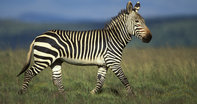
Name
Cape Mountain Zebra (Equus Zebra Zebra)Appearance
Measuring 1.16 m to 1.2 m, with a mass of 230 to 260 kg, the Cape mountain zebra is the smallest of the zebra species. Its long ears measure about 220 mm, and it has distinctive dewlaps.
In comparison to the Burchell’s zebra, the Cape mountain zebra has more and thinner stripes on its body. The horizontal stripes circling its legs run down to the hooves. The hind quarters are covered in thick black stripes, and the rump has a gridiron pattern of black lines, whereas the belly is purely white.
Cape Mountain Zebra Breeding
Under the leadership of one stallion, the Cape mountain zebra congregates in herds of one to five mares and their foals. Stallions not belonging to herds gather to form bachelor groups.Where they are found
The Cape mountain zebra used to be widely distributed in South Africa, found in the Eastern Cape mountain ranges and the Western Cape. However, due to extensive hunting, they almost became extinct in the 1930s.
The Mountain Zebra National Park was established in 1937 in the Cradock region of the Eastern Cape in the effort of saving this species. Today, there are only three naturally occurring populations of Cape mountain zebra in South Africa, found in the Mountain Zebra National Park, the Kammanassie mountains and the Gamka mountains.
New and smaller populations have developed from Cape mountain zebras translocated from the Mountain Zebra National Park, found in the Klein Karoo on small game reserves and in the Eastern Cape.
De Hoop Nature Reserve is home to individuals also translocated from the Kammanassie mountains and now extinct populations of the Outeniqua and Kouga mountains in South Africa.
Field Notes
When the Cape mountain zebra was under the threat of extinction, its population numbers had dropped below 50. The South African government thereby established the Mountain Zebra National Park, despite strong opposition.
The Cape mountain zebra won the vote, despite having been described as ‘donkeys in football jerseys’ in Parliament.
 Learning about the mammals of South Africa is now so much easier for all South Africans - SouthAfrica.co.za is an excellent source of inform...
Learning about the mammals of South Africa is now so much easier for all South Africans - SouthAfrica.co.za is an excellent source of inform... Two species of zebra dominate the wild plains of South Africa. They are the Plains or Burchell’s zebra and the mountain zebra. The differe...
Two species of zebra dominate the wild plains of South Africa. They are the Plains or Burchell’s zebra and the mountain zebra. The differe...